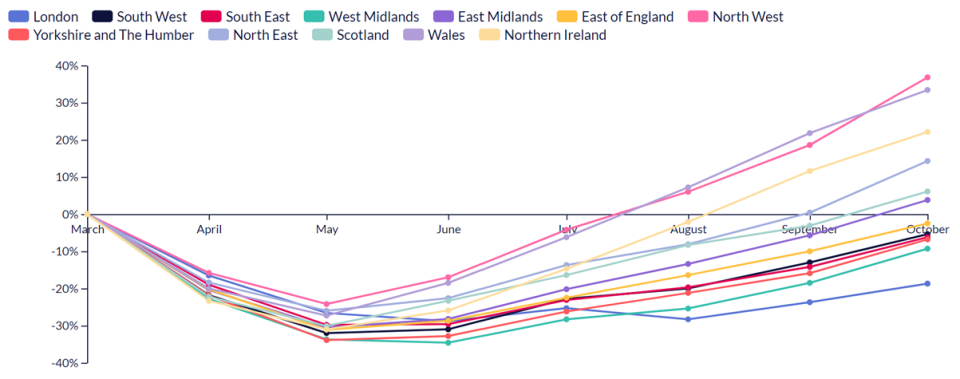COVID-19 triggers 'stark' divide in hiring across the UK

New figures reveal a “stark difference” in hiring patterns across the UK, with recruitment in some parts of the country lagging well behind others.
A leading survey of recruiters shows the continued hit to the jobs market from the coronavirus in large swathes of the UK, with demand for staff falling most in London. Job adverts earlier this month were down 18.7% on pre-lockdown levels.
Recruitment remains subdued in six English regions — but has exceeded March levels in every other nation and in much of northern England.
Data from the Recruitment & Employment Confederation (REC) puts total active job adverts in the UK as a whole at 1.36m in the first week of November, surpassing levels seen in March.
A poll of REC members suggests north-west England has seen the biggest leap in active job postings between March and October, up 36.8% to more than 238,000 roles. It was closely followed by Wales, up 33.4% to almost 59,000 roles.
Ads were also up in Northern Ireland, north-east England, Scotland and the East Midlands.
READ MORE: UK unemployment rises at fastest pace since 2009 as redundancies hit record high
London saw the steepest declines though vacancies remained highest, reflecting the capital’s size and economic dominance with almost 401,000 roles reported by the REC. The West Midlands had the second biggest decline, down 9.3%, followed by Yorkshire & the Humber, down 6.8%.
“This recovery has not been evenly distributed across the different regions and sectors of the UK labour market,” said the REC’s Jobs Recovery Tracker report.
WATCH: UK redundancies hit record high in the third quarter of 2020
The report also shows large disparities between different sectors’ fortunes. Recruitment has soared in industries benefiting from additional demand during the crisis such as food and drink production, logistics, health and care and construction, but tanked in hard-hit hospitality and leisure.
The roles with the biggest positive change in demand since March include food, drink, and tobacco process operatives, up 53.2% with 1,538 roles reported as available. Some 112,149 nursing roles are also reported, up 39%. Postings are also up for HGV drivers, carpenters, joiners, cleaners and carers.
The biggest decline in demand is for bar staff with hospitality hamstrung by restrictions throughout the crisis, including enforced closure during England’s current lockdown. Chef, fitness instructor, barber and hairdresser roles are also far fewer in number than in March.
“With the stark difference in demand across different regions, avoiding a skills mismatch will require serious planning,” said Neil Carberry, chief executive of the REC.

READ MORE: Jobseekers see 31% drop in Christmas roles and biggest graduate job slump since 2009
Carberry said recruiters could play a key role given their knowledge of sectors and areas, but said the government could help by letting employers continue to check applicants’ right to work virtually, a temporary measure introduced during the pandemic.
He also said UK immigration reforms should “reflect the severe shortages” facing some sectors like food manufacturing. The apprenticeship levy should meanwhile be broadened so employers can use funds for a wider range of training for all staff, according to the REC.
Matthew Mee, director of workforce intelligence at Emsi, which produces the data with the REC, said: “One of the most interesting developments we are seeing in terms of employer demand is the ‘London Lag’, which is seeing the capital return to pre-Lockdown levels at a much slower rate than other regions of the country.
“When we couple this with the fact that furlough take-up has been higher in London than elsewhere, and that the highest rise in claimant counts has been in the London commuter belt, it seems that the restrictions since March may well have had a greater proportionate impact on the capital than on other regions of the country.”
He added: “With discussion this week around a potential COVID vaccine coming closer to fruition, and the rise in confidence this brings, it will be interesting to see how this impact hiring activity in coming weeks.”
WATCH: What is the job support scheme and how has it changed?

 Yahoo Finance
Yahoo Finance 